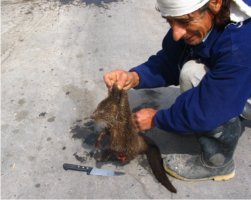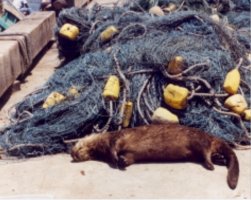 |
Last Update:
Thursday November 22, 2018
|
| [Home] |
The marine otter (Lontra felina) is an endangered species living along the coast of Perú, Chile and far south of Argentina. The species is classified as “threatened” by IUCN (Medina-Vogel, 2004) and the Peruvian government (Ministerio de Agricultura, 2004). In Peru, the species is restricted to Central Peru and Humboldtian ecoregions (Sullivan and Bustamante, 1999). The marine otter is protected in Peru only within the Reserva Nacional de Paracas, on the central coast. In addition, some coastal land owned of the Company Proabonos S.A. serves as haven for marine otters in Peru. In the remaining areas, marine otters are threatened by accidental capture by local fishery activity. In southern Peru marine otters are caught in demersal gillnets. Marine otters are also killed intentionally because of conflicts with fish and prawn fishermen (Chehebar, 1990). Historically, marine otters were abundant in Paracas and Morro Sama in Peru (Brack-Egg, 1978), but more recently, the population of marine otters between Lima and Tacna was estimated to be 690 individuals (Apaza et al., 2004), while the southern coast of Peru has a local population of 88 individuals (Alfaro and Mangel, 2008). The largest population on a local level is located in Morro Sama with 8 individuals (Apaza et al., 2002). Along with Vila-vila, this is the southernmost site inhabited by L. felina in Peru. Here the otters live in artificial dens in docks and harbours. The marine otter is a species with isolated distribution of small populations caused by habitat fragmentation and loss of habitat (Medina-Vogel et al., 2008). In these cases there is an increased risk of extinction by loss of heterozygosity, inbreeding and the evolutionary consequences of erosion of genetic variation (Soulé and Simberloff, 1986). MATERIALS AND METHODS Study Area The study area comprises the fishing villages of Morro Sama (17°59' S 70°50' W) and Vila-vila (18°07' S 70°40' W) located in the department of Tacna, southern Peru. The port of Morro Sama was established in 1998 and has a population of two hundred fishermen. Vila-vila was recognized as a fishing village in 1970 by Peruvian government and has a current population of 350 fishermen. Morro Sama has one wave breaker and two docks and Vila-vila has one dock and two wave breakers. Small-scale fishing is the predominant activity. Methods Between January 2006 and November 2008, the density of otters and the number of deaths were recorded along with the causes of mortality. Information on mortality and causes of death were collected by direct observation with the use of binoculars (taking photographs when possible) and using interviews with local fishermen and workers of government agencies. During interviews, the site, number of dead otters and evidence of the report (as photo, fur or other witness) were recorded. The causes of death were classified as: entangled, poisoned, killed by dogs, and confined accidentally in boats and unknown. Densities were estimates at both sites by conducting 2-3 censuses per month. Otters were counted by direct observation with binoculars (8x40) whilst walking a distance of 1km along the breakwater, docks and rocky seashore, following the recommendations of Medina-Vogel (2006). The duration of surveys was four hours. Observations took place during the morning (8-12 h.) or the afternoon (12-16h). The site was divided into four areas: rocky beaches, breakwaters, sea near the docks and docks. Each area was scanned for 1 hour. In the case of observations of groups only the observation with the highest number of individuals was counted in each survey. The observation stopped when the sighted group disappeared. Altogether 51 surveys were conducted on each site. The density was estimated by calculating the mean of maximum individuals counted/km during a year for each siteRESULTS The mean annual observation of death otters was 5 otters in Morro Sama and Vila-vila. But the number of deaths is greater in Vila-vila. The results show a higher quantity of otters stranded, compared to otters entangled and trapped accidentally in boats (Table 1). According to regional government workers in Vila-vila, the use of rat poison caused the death of three otters, when the harbour was cleaned from rats. Another case was a casualty caused by a dog in Morro Sama, when a pit-bull dog killed a young male otter near a den (Fig. 1).
The density estimation of otters indicates a population decreasing in Vila-vila and Morro Sama since 2006 until now (Table 2). The mean density decreased in Morro Sama from 8 otters/km in 2006 to 4 otters/km in 2008. In Vila-vila the density decreased from 6 otters/km in 2006 to 3 otters/km in 2006. DISCUSSION Deaths of marine otters by predators and disease were not studied in this work. Predators mentioned in the literature (Larivière, 1998) as Orcinus orca and sharks are not common near the shore in the study zone. The cause of mortality of stranded otters is unknown. However it is likely related to the interaction with local fishing activities, since fishermen chase otters with boats. This is a common problem on the Peruvian coast and is mentioned by Valqui (2004) in their study on the interaction of marine otters with boats owners in Pucusana port, on the central coast of Peru. Deaths of Marine otters were more frequent during winter and spring months (86%). In these months the Dolphin fish (Coryphaena hippurus Linnaeus 1758) and Jumbo squid (Dosidicus gigas D´Orbigny 1835) fisheries decreased their activity in southern Peru and many fishermen have no work. This situation could increase the human pressure on the coastal marine resources during these months. Otters can become entangled and drown in a type of gillnet called a “cortina”, with a mesh size of 3.8 cm and 14.5 cm (Figure 2). Fishermen mention that these nets are employed to catch small quantities of fish such as: Sciaena deliciosa, Sciaena gilberti and Cheilodactylus variegatus. Recently Caceres (2008) encountered the presence of otholites of Cheilodactylus variegatus in 5.4% of spraint samples of L. felina from Vila-vila. Therefore competition for resources occurs between otters and people. The density of otters in Morro Sama and Vila-vila declined by 50% between 2006 and 2008. Overall the current density in the study area is high when compared with densities recorded by other authors on the northern coast of Chile and central-south coast of Perú (Cabello, 1977; Ebensperger and Castilla, 1991; Apaza et al., 2004; Alfaro and Mangel, 2008) (Table 2). On the other hand, densities of marine otters in central and south Chile are higher than those recorded in this study (Castilla, 1982; Medina-Vogel, 1995; Medina-Vogel, 2006). Following to Van Horne (1983) this indicates that sites with greater densities of marine otters represent zones with better habitat quality for this species. CONCLUSIONS Many deaths of marine otters in the villages of Morro Sama and Vila-vila occur as results of interaction with local people and small-scale fisheries. More deaths were recorded in the village of Vila-vila than in Morro Sama, perhaps due the differences in population densities between the areas. The density of marine otters in Vila-vila is lower than in Morro Sama, perhaps due the higher levels of disturbance by humans in the form of tourism, shellfish harvesting and fishing. Morro Sama exhibits a greater estimated density of marine otters in comparisons with other localities of Perú and northern Chile. The possibility of the establishment of a marine protected area in Morro Sama should be considered. This is of high importance because of the still relative high density of marine otters and the overall threats for the species. Regulations on the use of “cortina” gillnets limiting their employment near the caves and dens inhabited by marine otters could reduce mortality of this Threatened/Endangered species, and prove to be a simple and effective conservation measure. Assuming the detection of den sites could be assured and the restrictions enforced.ACKNOWLEDGMENTS - The literature provided by Jeffrey Mangel, Joanna Alfaro and Celia Caceres was very important to this work. Many thanks to Loly Silva for the facilities in Morro Sama and to the fishermen of Vila-vila and Morro Sama villages for the information about marine otters. REFERENCES Alfaro, J., J. Mangel. (2008). Comunidades pesqueras y la conservación de la Nutria Marina (Lontra felina) en el sur del Perú. Conservación Regional (Perú) 2: 5-10. Résumé : La Mortalité de la Loutre Marine dans le Sud du Perou Resumen: Mortalidad de la Nutria Marina (Lontra felina) en el Sur del Perú |
| [Copyright © 2006 - 2050 IUCN/SSC OSG] | [Home] | [Contact Us] |


